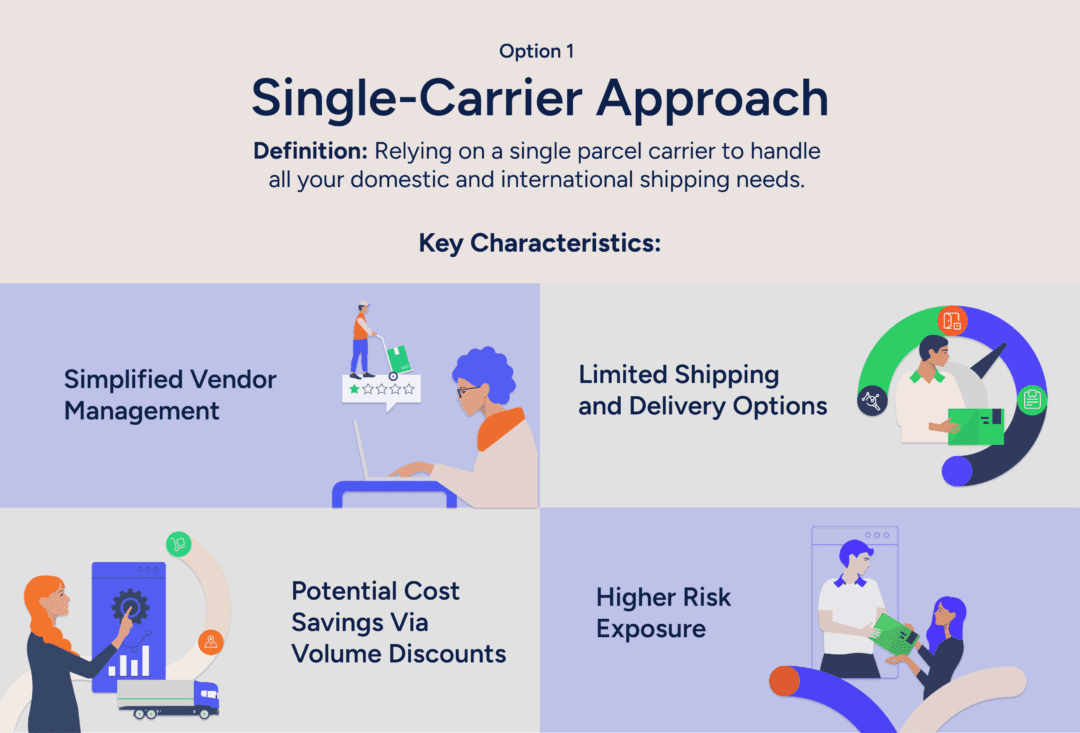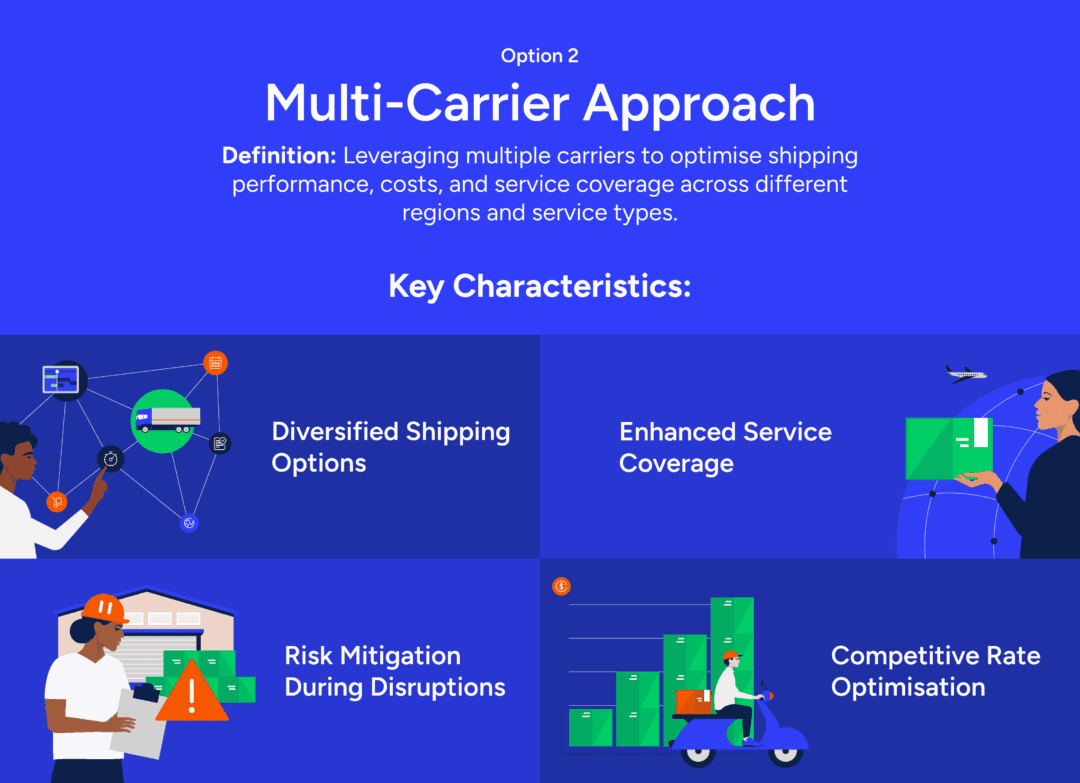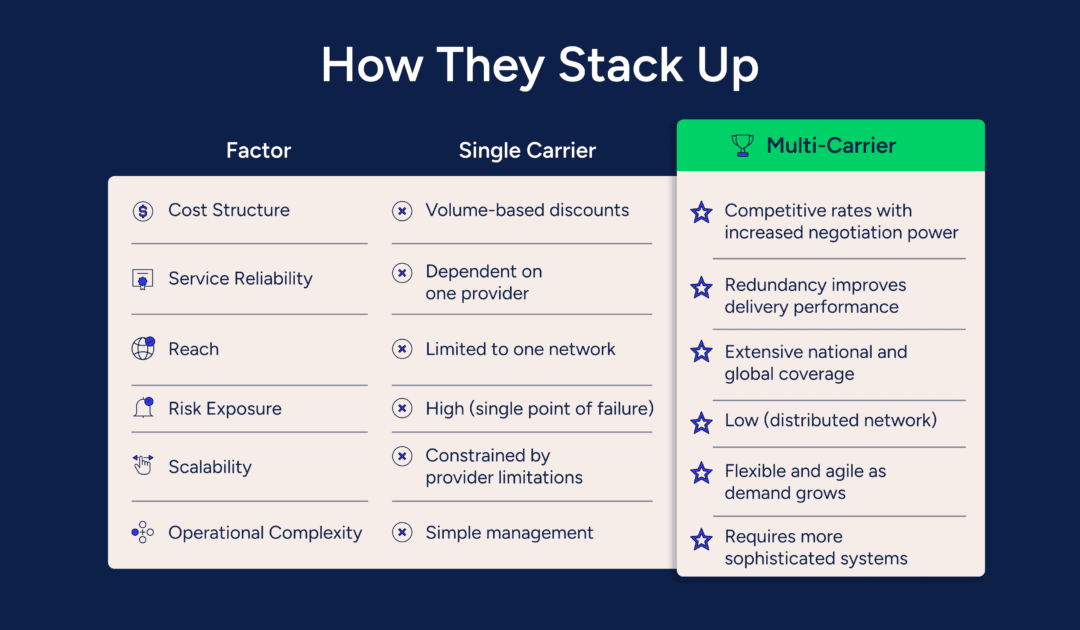
Shipping strategy isn’t just an operational consideration—it’s a critical business decision that directly impacts your bottom line, customer satisfaction, and long-term growth potential. So, needless to say, there’s a lot at stake.
It comes down to two shipping approaches: multi-carrier and single-carrier. In this blog, we’ll explore the pros and cons of both strategies, the differences between multi-carrier and single-carrier shipping, and which approach is best for your enterprise business.
Key Takeaways
- Single-carrier shipping relies on one parcel carrier to handle your shipments. It offers simplicity but can create vulnerability.
- Multi-carrier strategies leverage multiple carriers to select the best carrier for each specific shipment.
- The right approach for your ecommerce business depends on costs, service, scalability, and operations.
- Only 1 in 14 retailers is currently deploying mature multi-carrier strategies.
What is Single-Carrier Shipping?
Single-carrier shipping involves relying on one parcel carrier to handle all your domestic and international shipping needs. This approach means consolidating your entire shipping volume with a single provider, creating one primary relationship for all your logistics requirements.
This strategy appeals to many ecommerce enterprise operations because of its simplicity: one contract, one relationship, one system to manage.

What is Multi-Carrier Shipping?
Multi-carrier shipping is a strategy that involves leveraging multiple carriers to ship across different regions and service types. Rather than putting all shipping volume with one provider, ecommerce businesses will diversify across several carriers, selecting the best option for each specific shipment. Ultimately, multi-carrier shipping is used to optimise shipping performance, costs, and service coverage.
This approach allows companies to choose carriers based on various factors such as destination, package type, delivery speed requirements, and cost considerations.

Pros and Cons of Single-Carrier Shipping
Oftentimes, we gravitate to the most simplistic approach. Especially considering all of the moving parts within an ecommerce enterprise business, simple may seem like the best option. But is it? Here are the pros and cons of single-carrier shipping:
Pros of Single-Carrier Shipping
- Simplified vendor management: One relationship to maintain, one contract to negotiate, and one system to integrate
- Volume discounts: Consolidating all shipping volume can lead to significant cost savings through preferential rates
- Stronger carrier relationship: Building a deeper partnership with your chosen carrier can lead to better service and support
Cons of Single-Carrier Shipping:
- Limited shipping options: Constrained by what your chosen carrier offers in terms of services and coverage
- Higher risk exposure: Creates a single point of failure—if your carrier experiences disruptions, your entire operation is affected
- Reduced negotiation power over time: Without competitive pressure, carriers may become complacent about rates and service improvements
- Geographic limitations: Restricted to your carrier’s network coverage and service quality variations
Pros And Cons of Multi-Carrier Shipping
A multi-carrier approach is more complex than a single-carrier one, but it can also provide more cost savings, negotiating power, and flexibility. Here are the pros and cons of multi-carrier shipping.
Pros of Multi-Carrier Shipping:
- Diversified shipping options: Access to a wide range of services, delivery speeds, and specialised solutions
- Enhanced service coverage: Extensive national and global reach through diverse provider networks
- Risk mitigation: Access to a variety of carriers and services protects against carrier-specific disruptions
- Competitive rate optimisation: Ability to leverage competition between carriers for better pricing
- Flexibility and agility: Can adapt quickly to changing business needs and market conditions
Cons of Multi-Carrier Shipping:
- Operational complexity: Requires more sophisticated systems and processes to manage multiple relationships
- Higher management overhead: More contracts to negotiate, relationships to maintain, and integrations to manage
- Potential for inconsistent service: Different carriers may provide varying levels of service quality

Which Approach is Right For Your Enterprise Business?
The best shipping strategy for your ecommerce business will ultimately depend on several key factors, including:
- Cost Structure: While single carriers offer volume-based discounts, multi-carrier strategies often provide better overall value through competitive rates and increased negotiation power across multiple providers.
- Service Reliability: Single-carrier approaches create dependency on one provider’s performance, whilst multi-carrier strategies build in redundancy that improves overall delivery performance.
- Market Reach: Single carriers limit you to one network’s coverage, whereas multi-carrier approaches provide extensive national and global reach through diverse provider networks.
- Risk Exposure: Perhaps the most critical factor—single carriers create a single point of failure, whilst distributed networks significantly reduce risk exposure.
- Scalability: Single carriers can constrain growth when you hit their capacity or service limitations. Multi-carrier strategies offer flexibility and agility as demand grows.
- Operational Complexity: This is where single carriers have a clear advantage with simple management requirements, though modern shipping platforms can largely mitigate the complexity of multi-carrier operations.

Here are a few scenarios to help you make your decision:
- Do you have the time to manage multiple shipping carriers? If not, a single-carrier approach may be the best fit.
- Does your ecommerce business see massive order volumes during peak season? To minimise risk and streamline operations during high-volume periods, you should consider a multi-carrier approach.
- Is your ecommerce business interested in global expansion? If yes, consider a multi-carrier approach.
Which Shipping Approach Wins? Multi-Carrier or Single-Carrier?
Given the clear advantages in cost optimisation, risk mitigation, service quality, and scalability, the question isn’t whether enterprises should adopt multi-carrier strategies—it’s why so few have done so already. A staggering statistic reveals that only 1 in 14 retailers are deploying a mature multi-carrier strategy.
As competition intensifies and customer expectations continue rising, businesses that continue with single-carrier approaches may find themselves at a significant disadvantage. The enterprises that will thrive are those that embrace the complexity of multi-carrier strategies and leverage technology to turn that complexity into a competitive advantage.
Ready to explore a multi-carrier shipping strategy? With access to 350+ carriers and more than 4,000 services through Metapack’s advanced delivery management platform, enterprises can now enjoy all the benefits of multi-carrier strategies without the traditional operational burden. Request a demo here.
